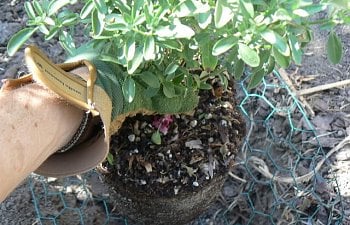The chickens get access to the majority of my backyard for free ranging, but now a days you would not think it looking at the yard. The first season with chickens, the yard didn’t look as good as it used to. There was poop on the concrete, plants uprooted or heavily munched, and holes in the lawn. Over time I have learned and figured out strategies for keeping the mess and damage down. Now, two years later, it looks lush, unmolested, and the grass is the greenest it has ever been. This was not achieved through permanently incarcerating the chickens, rather it was managed while I still had my Large Fowl flock that free ranged all day long.
Fencing
I keep my veggie garden and other yummy plants fenced off from the area the chickens get to occasionally roam. The fence is picket style and they don’t like to hop on top of the pointy shaped boards.
http://hanburyhome.files.wordpress.com/2010/12/p1190389.jpg
Joey longingly looking into the veggie garden from outside the fence
http://hanburyhome.files.wordpress.com/2010/12/p1180722.jpg
Pet fencing used to protect a small newly planted area from the chickens
I do allow the chickens access to vegetable garden either in their pen (a dog exercise pen with bird netting) or when I am able to supervise. At the end of the growing season, I allow them into the veggie garden to help “clean up.”
Plant Protection
Since getting chickens, I have been using chicken wire around the base of the root zones of plants when I first put them in the ground. I lay it on the ground with any sharp parts trimmed off or poked in the ground. Then I put landscape staples or clothes hanger pieces through it to hold it in place and cover with mulch. The chickens avoid scratching over it, but are able to walk on it. This prevents the chickens from digging the plants out before the plants are firmly rooted in the ground. Here is a photo of some of one my chicken proof planting methods.

Chicken Wire protection for a new plant
I have learned to keep a few large areas open for digging and dust bathing so the chickens don’t make new holes in the lawn or at the base of a favorite plant for the same purpose.
http://hanburyhome.files.wordpress.com/2010/12/p1180225.jpg
I love this weird photo of Vader. It looks like she is a scary headless chicken. In reality, she dug her self the perfect dust bathing hole in the middle of the lawn.
Less Time to Damage
With our second flock, I have limited the amount of time they get each day to free range, and some days I don’t let them out at all. They only come out when I have time to supervise. I do not want them to get into the habit of expecting to be out all day long like our other flock did. Also, bantams are a nice size treat for hawks so I am more careful with them.
Choose Wisely
I keep a list of my plants the chickens leave alone at my blog and here at BYC. I also check Sunset Western Garden book before purchasing new things to see if they are “deer proof.” Most deer proof plants are also chicken proof. Large shrubs and fruit trees seem to work especially well with chickens, but with a little extra care, smaller stuff can work too.
Chicken Poop
To minimize the droppings on the concrete, I use the same portable pet fencing to temporarily block off the areas I want to keep them off. I found two of them on craigslist for about $10 each, and the other two were given to me.
http://hanburyhome.files.wordpress.com/2010/12/100_2297.jpg
Portable dog fencing enclosure to temporarily contain chickens
